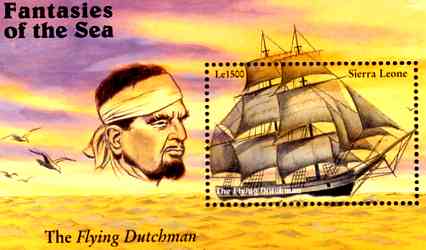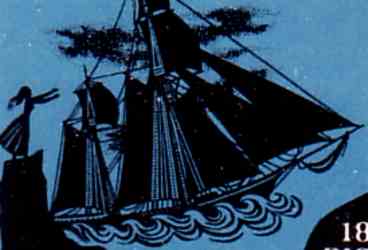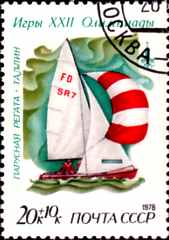|
|
The 'Flying Dutchman' is a sailing ship which has been spotted on the
oceans for centuries. According to the myth it's captain is the bearer
of a terrible curse and possessed by the devil as well.
If the ship meets another vessel, some members of the awful crew come
alongside in a small boat and ask for delivery of a bundle of mails.
These letters have to be nailed to the mast immediately,
otherwise misery will happen to the vessel, because the letters are
addressed to already dead persons!
Today, a lot of different stories, legends and myths, a stage-play, a movie and even an opera concerning the Flying Dutchman exist. |
 |
The most horrible legend tells about a Dutchman named van der Decken. The crew of his very fast ship was constantly gambling, cursing and carousing. No one was allowed to enter his cabin, because there he had his meetings with the devil. The devil and van der Decken had a standing agreement. Van der Decken kept a house of his own behind the dunes, which was watched over by a witch. Everytime he returned from a long voyage a young girl was already waiting in his bed for his pleasure. The devil arranged for that. |
| When it was time to depart, van der Decken and the witch took the girl, broke her neck, sewed her into a bag and threw the bag into the sea. But once the devil caught a very beautiful girl just in front of a church. This maiden resisted van der Decken, cried for mercy and prayed for her freedom. Then suddenly a halo of glory appearead above her. Without further ado the enraged van der Decken broke her neck and threw her into the sea, like all the others. | |
| But the devil was not satisfied and made the head of the beautiful girl appear in the waves, calling 'Follow me, Follow me!'. To van der Decken he whispered: 'Do it, you can catch her!' And from then on he is sailing over the oceans, following the bright light around the head of the beauty to all eternity without ever catching her. |  |
| Another story was told about a Bernhard Focke. He did so terrifically fast voyages to East India, only the devil could be his companion. | |
| After earning untold riches with his fast voyages the devil came to claim his tribute, but Focke refused his part of the deal. So he was cursed to sail between the southern Cape's forever without a chance to contact another person. | 
|
|
Countless different versions exist about the reasons which caused the
banishment. In another saga the Flying Dutchman was sailing in a heavy
storm off the Cape of Good Hope. The hurricane blew so strong, that it
was impossible to round the Cape. But the captain swore by all devils,
to sail around the Cape even if it would last until Judgement Day.
The devil took him by his words and so he is still sailing through the
oceans with no hope of return. There is a similar version, in which the term 'storm' is replaced by 'calm sea'. |
 |
In another version van der Decken (again) sailed through heavy storm and high seas. He cursed the weather and swore even to defeat the Almighty to reach the Table Bay. Suddenly an angel appeared on the deck of the ship. Van der Decken denied to take off his cap and shot at the apparition with his pistol. Thereupon the divine visitor condemned him and his ship to sail the oceans from here to eternity. |
| A lot of sailors have encountered the Flying Dutchman. Once he sailed in the doldrums with full speed, once he sailed backwards over the sea, once he floated in a cloud above the horizon. If one sees him, it is a bad omen and misfortune for the ship and the crew is bound to happen. Legend tells a crewmember, who saw the Flying Dutchman, fell from the mast the next day. A ship was caught for months in the doldrums or sank during the voyage. |
| Richard Wagner composed an opera about the Flying Dutchman and wanted to have a happy ending. He remembered another theme that the Flying Dutchman can be redeemed by the true devotion of a woman. The devil does not believe in true devotion and allows the cursed captain to go ashore every seven years where he can marry a wife and 'work' for his salvation. But the legend tells, that the Dutchman returns every time - happy to leave the wedlock. | 
|
| Wagner's opera ends with Senta, the woman of the Flying Dutchman standing on a high sea-reef. She reaches out to her husband on the ship in front of the reef. But the Dutchman really loves her and wants to leave her behind to protect her from the terrible curse. So he confesses his fate and tells her to return. |
 |
But then Senta is crying "Here I stand, faithful to you until death!" and throws herself into the sea. The ship sinks, the Dutchman is redeemed and they are then seen rising to heaven together. |
|
|
This is the way how legends and sagas speak of the Flying Dutchman.
Now we want to speak about a 'real' Flying Dutchman of our times.
|
 |
 |
The abbreviation 'FD' stands for Flying Dutchman. Some specifications:
Length - 20ft, Beam - 6ft, Draught 3.7ft with the sword Sails: mainsail 11 sqm, genoa 6 sqm, spinnaker 21 sqm constructed by the Dutch (!) Uus van Essen. This small and light boat type is very fast, will be sailed with a special rigg and is able to reach surflike speed. This boat type has it's own World and European Championships and was part of the schedule of quite a few Olympic Games. |
 |
Both heads depicted earlier on this page are from this beautiful
stamp of Guernsey. It was issued in 1997 together with another stamp
about Victor Hugo's novel 'Toilers of the Sea' and shows 'Gilliats
end'. The last big illustration ' .. from here to eternity' is an enlargement of an Ugandan stamp showing a barque. The Bulgarian stamp shows a painting of Senta and her Dutchman.
|
© 1998 - 2003 Bjoern Moritz, all rights reserved.
